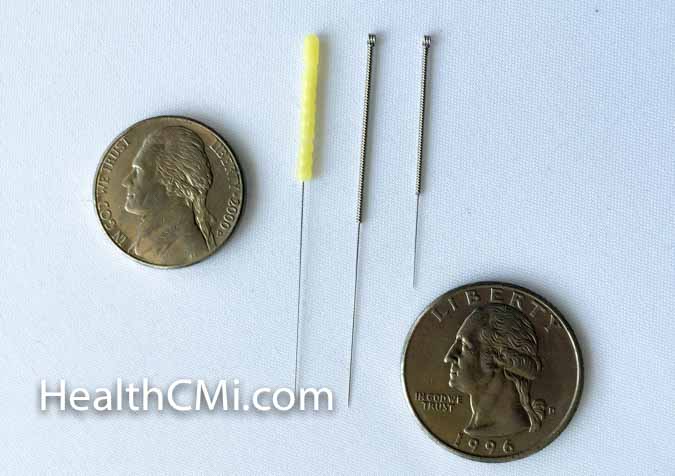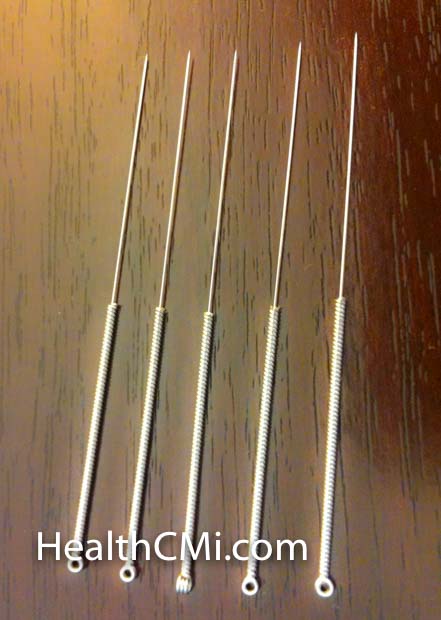Researchers conclude that acupuncture reduces symptomatic presentations and benefits brain responses as measured by EEG for children with ADHD (Attention Deficit Hyperactivity Disorder).
Researchers conclude that acupuncture increases the efficacy of biofeedback treatments and is also effective as a standalone therapy for children with ADHD. EEG results and symptomatic presentations significantly improved with the implementation of acupuncture therapy protocols. Acupuncture produced an 84.45% total effective rate as a standalone therapy and outperformed Chinese herbal medicine, which achieved a 78.77% total effective rate. Acupuncture combined with biofeedback achieved a 91.5% total effective rate. Take a look at the results in two groundbreaking studies.
 Japanese and Chinese Acupuncture Needles
Japanese and Chinese Acupuncture Needles
Zhang et al. conducted a clinical trial on the efficacy of acupuncture versus Chinese herbal treatments on young children for the treatment of ADHD (Attention Deficit Hyperactivity Disorder). ADHD involves inattention or hyperactivity and impulsiveness that complicates daily functioning and may contribute to developmental difficulties. According to the National Institute of Mental Health, ADHD is a brain disorder characterized by inattention, hyperactivity, and impulsivity.
Infants diagnosed with ADHD participated in the study. Results were based on symptomatic improvements and electroencephalogram measurements. A total of 592 patients were divided into an acupuncture group, Chinese medicine group, and a control group. For the acupuncture group, differential diagnostic pattern differentiation was used to determine a protocolized set of acupoints for each patient. For patients with liver and kidney deficiency, the following acupuncture points were applied:
- Sishencong (extra)
- Shuaigu (GB8)
- Naohu (GV17)
- Shenting (GV24)
- Neiguan (PC5)
- Sanyinjiao (SP6)
- Taixi (KD3)
Total needle retention time for the aforementioned acupoints was 20 minutes per acupuncture session. In addition, Meihua (plum blossom) acupuncture was applied to the Governing Vessel (Du Mai) and bladder meridians (Foot-Taiyang) using the tapping technique. A special focus was on acupoints Ganshu (BL18) and Shenshu (BL23) for the purposes of benefitting the liver and kidneys respectively. For patients with liver qi stagnation, the following acupoints were applied:
- Sishencong (extra)
- Shuaigu (GB8)
- Naohu (GV17)
- Shenting (GV24)
- Laogong (PC8)
- Taichong (LV3)
Total needle retention time for liver qi stagnation patients was 20 minutes per acupuncture session. Plum blossom needling was applied to the pericardium (xinbao) meridian and added for the upper limbs bilaterally.

Acupuncture as a standalone procedure achieved an 84.45% total effective rate. Chinese herbal medicine achieved a 78.77% total effective rate. This includes significant improvements in both groups for symptomatic improvements and electroencephalogram results. The statistics uncovered two important trends. First, the younger the patient, the greater the positive patient outcome rate. Second, patients receiving the liver qi stagnation protocol had greater positive patient outcomes than patients receiving the liver and kidney deficiency protocol.
In a related study, researchers compared two protocols. In one group, children received scalp acupuncture plus EEG biofeedback treatments for ADHD. In the other treatment group, children received only EEG biofeedback. Acupuncture plus biofeedback achieved a 91.5% total effective rate. Children receiving only biofeedback achieved an 83.3% total effective rate. Based on the findings, the researchers conclude that acupuncture plus biofeedback had an additive or synergistic clinical effect producing greater positive patient outcomes.
A total of 100 children with ADHD were equally divided into two groups: acupuncture plus biofeedback, biofeedback only. In the scalp acupuncture group, the following acupoints were needled:
- Dingzhongxian (MS 5)
- Dingpangyixian (MS 8)
- Baihui (GV 20)
- Sishencong (EX-HN 1)
Additional scalp acupuncture points were also added. After four sessions of acupuncture, several indices demonstrated superior patient outcomes for patients with acupuncture plus biofeedback over using only biofeedback. This included the Wechsler Intelligence Scale for Children (WISC), Conners ADHD Index, and the ratio of O wave and P wave in EEG, FRCQ and FAQ in the integrated visual and auditory continuous performance test (IVA-CPT).
The studies covered in this review demonstrate that acupuncture is an effective modality for improving patient outcomes for children with ADHD. More rigorous trials to test and confirm the results are warranted based on the findings. Given the complexity of ADHD and its treatment regimens, further investigations may help codify specific protocols yielding maximum efficacy.
References:
Hong L (2004) Prof. ZHANG Jia—Wei. ClinicaI Study on Acupuncture Treatment of 380 Cases of Infantle Atention—deficit Hyperactivity Disorder. Shanghai Zhenjiu 23.
Ni XQ, Zhang JY, Han XM, Yin DQ (2015) [A Meta-analysis on Acupuncture Treatment of Attention Deficit/Hyperactivity Disorder]. Zhen Ci Yan Jiu 40: 319-325.
He CD, Lang BX, Jin LQ, Li B (2014) [Attention deficit hyperactivity disorder treated with scalp acupuncture and EEG biofeedback therapy in children: a randomized controlled trial]. Zhongguo Zhen Jiu 34: 1179-1183.
National Institute of Mental Health, National Institutes of Health. (2016). Attention Deficit Hyperactivity Disorder. Bethesda, MD: U.S.
Li S, Yu B, Zhou D, He C, Kang L, et al. (2011) Acupuncture for Attention Deficit Hyperactivity Disorder (ADHD) in children and adolescents. Cochrane Database Syst Rev: CD007839.


